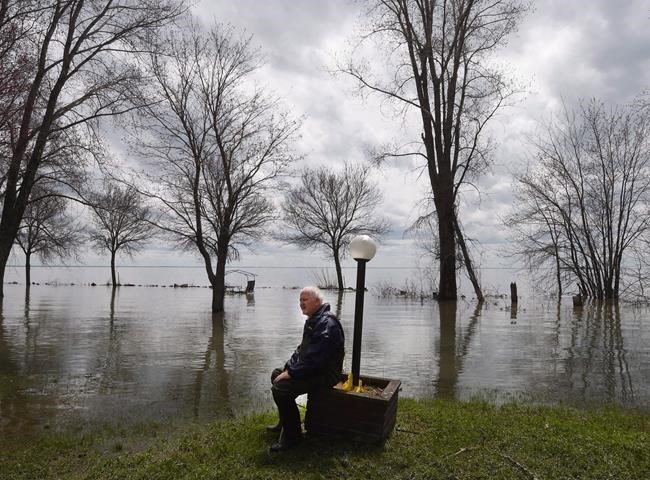
Paul Diamond takes a break from walking through the floodwaters from Lac-Saint-Pierre to check on his cottage, Saturday, May 13, 2017 in Yamachiche, Que. Environment Canada's chief climatologist has compiled his top weather stories of 2017 - a year which David Phillips says was marked by unusually long periods of conditions that just wouldn't go away. THE CANADIAN PRESS/Ryan Remiorz
December 21, 2017 - 2:00 AM
Environment Canada's chief climatologist has compiled his top weather stories of 2017 — a year which David Phillips says was marked by unusually long periods of conditions that just wouldn't go away. His Top 10:
1.British Columbia's Longest and Most Destructive Wildfire Season: The province was forced to declare its longest-standing provincial emergency when 1,265 fires scorched 12,000 square kilometres of forest, bush and grassland. About 50,000 people were forced to flee. The fires came during the province's driest summer on record.
2.Dry and Hot in the West: Summer temperatures broke records — Medicine Hat, Alta., recorded 34 days of plus-30 C weather — and it was so dry that Regina was 22 per cent under its previous record for low rainfall. On the bright side, no rain meant no mosquitoes.
3. Spring Flooding in Quebec and Ontario: Montreal and Ottawa had their wettest springs in history. In May, rivers from Gananoque to Gaspesie flooded past historic maximum flows. More than 5,000 residences were swamped and 550 roads were washed out by floods or covered by landslides. Two people were swept away by the swollen Sainte-Anne River in the Gaspé region.
4.British Columbia's Cold and Snowy Winter: The West Coast was shivering through its second coldest winter in the last 25 years. It was distinguished by the duration, frequency and length of snowfall and snow on the ground. Skiing was good, but public golf courses were closed for up to two months — the first such closures in 20 years.
5.Another Windsor flood: Two Storms of the Century in a Year. Less than a year after a record $153- million flood hit the Ontario city and surrounding area, another arrived on Aug. 28. In less than 48 hours, 222 mm of rain fell in southwest Windsor. Nearby LaSalle received 125 mm that day and another 160 mm the next. Curbs were piled high with waterlogged carpets, spoiled furniture, broken appliances and sodden belongings.
6.Central Canada's Missing Summer: Total rainfall from April to July around the Great Lakes and St. Lawrence River was the highest in 70 years. Cool temperatures, overcast skies and frequent spring showers hung around all summer. Farmers were weeks behind schedule. Lake Ontario reached an unprecedented 75.9 metres above sea level in May. The Toronto Islands were off limits from mid-May to the end of July.
7.A New Storm of the Century: A storm struck Ontario on March 13 before moving into Quebec and Atlantic Canada. It led to a multi-car pileup, in whiteout conditions, involving 15 transport trucks and other vehicles on Highway 401. The highway was closed as twisted metal littered the road and a toxic acid spill polluted the air. The storm then dumped 50 centimetres of snow at more than half the reporting stations in southern Quebec. No previous storm eclipsed so many snowfall records. The storm killed five people.
8.Summer in September: The first day of fall marked Central Canada's warmest weather. From Sept. 22 to Sept. 27, more than 1,000 heat records tumbled as humidex values shot up close to or above 40, prompting a week-long stretch of heat warnings. Southern Quebec had its warmest October since at least 1870.
9.Newfoundland's Brier Blast: Hurricane-force winds ravaged Newfoundland on March 1 and 2, but it was the "Brier blast" on March 11 that saw winds on the Avalon Peninsula peak at Bay de Verde at a hurricane-force of 190 km/h. Some 70,000 residents and visitors were left in the dark, trees were uprooted, traffic lights and power lines toppled, and the second-storey of some homes ripped off.
10.New Brunswick's Glaze Storm: A long-lasting mix of rain, snow, freezing rain and ice pellets over Quebec and Atlantic Canada in late January killed two and injured dozens. Nearly 300,000 residents were left in the dark and cold after power lines snapped. Some communities were without electricity for up to 12 days. Canadian troops were deployed to help with the ongoing emergency response.
News from © The Canadian Press, 2017